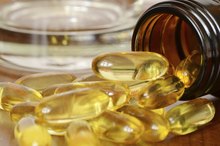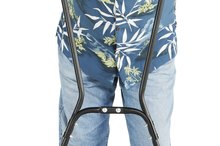What does fact checked mean?
At Healthfully, we strive to deliver objective content that is accurate and up-to-date. Our team periodically reviews articles in order to ensure content quality. The sources cited below consist of evidence from peer-reviewed journals, prominent medical organizations, academic associations, and government data.
- “International Journal of Impotence Research”; Stimulation of Collagen Production in an In Vitro Model for Peyronie’s Disease; S.K Ahuja, et al; August 1999
- “International Journal of Impotence Research”; Stimulation of Collagen Production in an In Vitro Model for Peyronie’s Disease; S.K Ahuja, et al; August 1999
The information contained on this site is for informational purposes only, and should not be used as a substitute for the advice of a professional health care provider. Please check with the appropriate physician regarding health questions and concerns. Although we strive to deliver accurate and up-to-date information, no guarantee to that effect is made.
Vitamin E Dosage for Treating Peyronie's
Peyronie’s disease is caused by fibrosis, or scarring, of the sheath surrounding the erectile tissues of the penis. This results in pain, angulated erections and difficulties with sexual intercourse. Peyronie’s is believed to be caused by genetic factors combined with relatively minor injuries to the penis that occur during intercourse. A number of treatments have been used for Peyronie’s, but most of them have shown limited benefit. Vitamin E is often recommended for this condition.
If you are experiencing serious medical symptoms, seek emergency treatment immediately.
Conservative Approach Recommended
Although surgery is useful for correcting Peyronie’s disease, some patients get worse after surgical treatment. During the first six to 18 months, Peyronie's can progress, remain stable or improve, and spontaneous resolution often occurs over the course of many months. Therefore, conservative management is recommended for at least the first year in most cases. This could include penile injections with calcium channel blockers, corticosteroids, antioxidants and interferon. Oral vitamin E is typically administered during all phases of treatment.
- Although surgery is useful for correcting Peyronie’s disease, some patients get worse after surgical treatment.
Vitamin E and Tissue Damage
Acetyl L-Carnitine and Peyronie's Disease
Learn More
In living tissues, vitamin E's primary benefits stem from its antioxidant properties. Aging and tissue degeneration are accelerated by free-radical-induced damage, and vitamin E neutralizes free radicals. A 1999 study in “International Journal of Impotence Research” showed that vitamin E prevented free-radical damage and reduced fibrosis in penile cavernosa cells in tissue culture 1. However, this same benefit has not been consistently demonstrated in patients with Peyronie’s disease.
- In living tissues, vitamin E's primary benefits stem from its antioxidant properties.
- A 1999 study in “International Journal of Impotence Research” showed that vitamin E prevented free-radical damage and reduced fibrosis in penile cavernosa cells in tissue culture 1.
Vitamin E Dosage
Studies evaluating vitamin E's benefits in Peyronie's disease have used varying dosages. There is apparently little evidence to recommend any particular dosage, and vitamin E’s effectiveness for treating this condition has yet to be confirmed. According to Dr. Wayne Hellstrom of Tulane University School of Medicine, a once-daily dose of 400 IU is a standard recommendation, but some studies have used 400 IU twice daily.
Considerations
Vitamins to Improve Sperm Motility
Learn More
Vitamin E has shown promise for limiting fibrosis in tissue culture models of Peyronie’s disease, but it has not consistently demonstrated benefit in patients with this disorder. Conservative management – including oral and injectable therapies – is recommended for all patients for at least one year, since many cases of Peyronie’s spontaneously resolve. Surgery is reserved for those men who do not respond to conservative treatment after one year and whose disease prevents them from having intercourse. Vitamin E, in doses of 400 to 800 IU daily, is a standard but unproven treatment.
- Vitamin E has shown promise for limiting fibrosis in tissue culture models of Peyronie’s disease, but it has not consistently demonstrated benefit in patients with this disorder.
- Conservative management – including oral and injectable therapies – is recommended for all patients for at least one year, since many cases of Peyronie’s spontaneously resolve.
Related Articles
References
- “International Journal of Impotence Research”; Stimulation of Collagen Production in an In Vitro Model for Peyronie’s Disease; S.K Ahuja, et al; August 1999
- “Urology”; Effect of Intralesional Interferon-Alpha 2b Combined with Oral Vitamin E for Treatment of Early Stage Peyronie’s Disease: A Randomized and Prospective Study; T. Inal, et al; April 2006
- Acikgoz, E.; Gokce, E.; Asci, R. et al. Relationship between penile fracture and Peyronie's disease: a prospective study. Int J Impotence Res. 2011;23:165-172. DOI: 10.1038/ijir.2011.24.
- Gelbard, M.; Goldstein, M.; Hellstrom, W. et al. Clinical efficacy, safety and tolerability of collagenase clostridium histolyticum for the treatment of Peyronie disease in 2 large double-blind, randomized, placebo-controlled phase 3 studies. J Urol. 2013 Jul;190(1):199-207. DOI: 10.1016/j.juro.2013.01.087.
- Herati, A. and Pastuszak, A. The Genetic Basis of Peyronie’s Disease: A Review. Sex Med Rev. 2016 Jan 1;4(1):85-94. DOI: 10.1016/j.sxmr.2015.10.002.
- Hussein, A. and Luea, T. All about Peyronie's disease. Asian J Urol. 2015 Apr;2(2):70-8. DOI: 10.1016/j.ajur.2015.04.019
- Kendirci, M.; Trost, L.; Sikka, S. et al. Diabetes mellitus is associated with severe Peyronie's disease. BJU Int. 2007 Feb;99(2):383-6. DOI: 10.1111/j.1464-410X.2007.06611.x.
- Stuntz, M.; Perlaky, A.; des Vignes, F. et al. The Prevalence of Peyronie's Disease in the United States: A Population-Based Study. PLoS One. 2016;11(2):e0150157. DOI: 10.1371/journal.pone.0150157.
- Usta, M. and Ipekci, T. Penile traction therapy for Peyronie’s disease—what’s the evidence? Transl Androl Urol. 2016 Jun;5(3):303-9. DOI: 10.21037/tau.2016.03.25.
Writer Bio
Stephen Christensen started writing health-related articles in 1976 and his work has appeared in diverse publications including professional journals, “Birds and Blooms” magazine, poetry anthologies and children's books. He received his medical degree from the University of Utah School of Medicine and completed a three-year residency in family medicine at McKay-Dee Hospital Center in Ogden, Utah.









